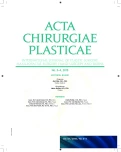A-18 Two methods to improve vascular supply of a DIEP flap
Authors:
D. Palenčár; Š. Krivosudský; K. Simonova; J. Fedeleš sen.
Authors‘ workplace:
Department of Plastic Surgery, Medical Faculty Komensky University, Slovak Medical University, University Hospital Bratislava, Bratislava, Slovakia
Published in:
ACTA CHIRURGIAE PLASTICAE, 57, 3-4, 2015, pp. 73-74
Category:
Selected abstracts from the 36th national congress of the czech society plastic surgery with international participation
Although the current use of DIEP flap in reconstructive surgery is well worked out and many authors publish its use with a high level of success and achieved vitality of the flap, still there are situations when we encounter an insufficient vascularization of the flap or imperfect venous drainage of the edges, possibly with late development of fat necrosis in a part of the flap.
DIEP flap has its vascular supply through musculocutanous perforators from the deep inferior epigastric artery. Venous drainage of the flap is mostly deep (via commitant veins) and sometimes the superficial venous system plays also an important role. In the preoperative planning today is most frequently used Doppler probe for detection of suitable musculocutaneous perforators. The usual hand Doppler probe however cannot determine the intramuscular course of the perforator and intramuscular or possibly submuscular course of the main vascular pedicle of the flap. The second problem may be determination of contribution of superficial venous system on drainage of DIEP flap.
The most frequent cause of DIEP flap necrosis includes vascular complications during operation. If there is a problem with early thrombosis of microanastomoses, possibly if the flap looks venostatic in the deep venous drainage, we expect insufficient vascular supply of the flap. Insufficient vascular supply of the flap may be due to a selection of inappropriate perforator, intraoperative trauma of the vascular pedicle of the flap, insufficient venous drainage through the deep system, technical error on the microanastomosis, kinking of the vascular pedicle, rotation of the vascular pedicle, pressure of a hematoma on the vascular pedicle. In case of uncomplicated surgical operation is occurrence of partial loss of the flap 5.1% and complete loss of the flap in 5.9% (1). If there are peroperative complications, however, the risk of partial necrosis increases to 21.4% and total necrosis of the flap up to 50% (1). Complications on the side of the veins result in flap loss in higher percentage in comparison with arterial complications.
Avoiding vascular complications in DIEP flaps is possible apart from others by generally accepted technique of creating microanastomoses and handling of tissue as well as by two main procedures. These include augmentation of venous drainage of the flap with superficial venous system and detailed preoperative detection of perforators using CT angiography examination.
Improvement of venous drainage of the DIEP flap can be provided by anastomosis of commitant veins as well as superficial system. It is important to detect superficial veins of the flap in preoperative planning on the caudal side of the flap and these veins should be freed, detected and dissected as long as possible and clamped. After complete dissection of the whole flap, it is suitable to keep it only on the undetached vascular pedicle (deep inferior epigastric artery and commitant veins) and wait for 20–30 minutes and observe vitality of the flap. Each zone of the flap becomes apparent and possibly is visible also venostasis in the whole flap. Together with significant filling of the stumps of the superficial veins this could indicate importance of superficial drainage system and then it is necessary to plan also microanastomosis with recipient veins. Sometimes the venous problems occur only after creating an anastomosis of commitant venous system on the recipient veins. Suitable recipient vein for the superficial system is sometimes sufficiently large perforator from the commitant vein of the internal thoracic artery, but it can also be the cephalic vein.
In order to improve planning and selection of the actual perforator, it is suitable to perform CT angiography examination. This contrast imaging method has a sufficient sensitivity for detection of perforators, it shows subcutaneous course of the perforator and visualizes intramuscular course of the perforator (and thereby provides information about the difficulty of dissection). CT angiography is also able to show the distance of perforator from the deep inferior epigastric artery and we are also able to determine the course of the main vascular pedicle of the flap.
During the preoperative planning of the DIEP flap it is important to consider all possibilities, which could occur during the operation. It is suitable to detect the superficial venous system of the flap right before the surgery with a Doppler probe. Addition of superficial venous system to the planning of DIEP flap could improve the venous drainage of the flap. CT angiography examination could also improve the preoperative planning and could accelerate the surgical time by providing a clear image of the vascular anatomy of the deep inferior epigastric artery and its intramuscular course and about the most suitable musculocutaneous perforator. (Fig. 18.1, 18.2.)


Sources
1. Fosnot J, Jandali S, Low DW, Kovach SJ 3rd, Wu LC, Serletti JM. Closer to an understanding of fate: the role of vascular complications in free flap breast reconstruction. Plast Reconstr Surg. 2011 Oct;128(4):835–43.
Labels
Plastic surgery Orthopaedics Burns medicine TraumatologyArticle was published in
Acta chirurgiae plasticae

2015 Issue 3-4
- Metamizole vs. Tramadol in Postoperative Analgesia
- Metamizole at a Glance and in Practice – Effective Non-Opioid Analgesic for All Ages
- Current Insights into the Antispasmodic and Analgesic Effects of Metamizole on the Gastrointestinal Tract
- Spasmolytic Effect of Metamizole
- Obstacle Called Vasospasm: Which Solution Is Most Effective in Microsurgery and How to Pharmacologically Assist It?
Most read in this issue
- 36th NATIONAL CONGRESS OF THE CZECH SOCIETY OF PLASTIC SURGERY WITH INTERNATIONAL PARTICIPATION
- Dorsoradial forearm flap with silicone bone spacer in reconstruction of A combined THUMB injury – case report
-
ZORA JANŽEKOVIČ
(September 30, 1918 – March 17, 2015) - Editorial
